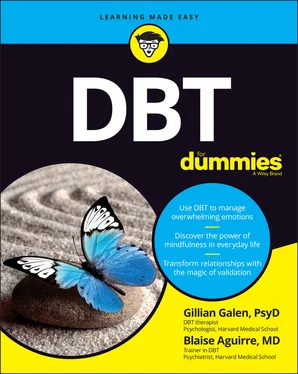Opening up — the topic of this section — means realizing that you’re open to seeing other possibilities as a way of understanding situations and open to other ways of solving difficult problems. Rather than acting on impulse as a sole solution, when you open up, life becomes less one-dimensional and allows you to take greater control of your life.
Seeing different perspectives
The shift in perspective-taking is a powerful way that DBT uses to help people transform the way they see something. This can happen in various ways:
If a person feels that they have screwed up and are unlovable, the therapist might ask them what they imagine their best friend would say.
A person may reflect on whether the way they are treating themselves is consistent with their wise mind. Wise mind is the dialectical synthesis of rational mind and emotion mind — where these two states of mind integrate into a single state that leads to a more intuitive, values-based, and holistic course of action.
In some sessions, therapists might take a more concrete approach to perspective-taking by switching seats with their patient, so that the patient literally has a different point of view.
Other techniques go beyond simply imagining another person’s perspective by imagining what a person’s younger self would say about a certain situation, or what their future self would say about their current actions.
The following sections dig deeper into different methods of seeing different perspectives.
Projective and reflective perspectives
Perspective-taking is considered to be projective or reflective:
Projective perspective means projecting a point of view into the future; for instance, a therapist, or you yourself, might ask the question: “How do you imagine you will look next year after you have completed therapy?” Of course, you can’t actually know what you’ll look like, so the only way to think about this is to project your feelings and thoughts onto what you imagine your future self might look like.
When perspective-taking is reflective, it requires the observation of the current experience. So, the therapist might ask, “If you viewed yourself after you had completed a course of DBT a year from now, and could remember yourself as you are today, how would you describe yourself?”
 The goal of projective perspective-taking is to help people broaden their awareness by looking outside of themselves. On the other hand, reflective perspective-taking focuses on getting a person to access insights about a current situation. Both of these styles of perspective-taking can be achieved within the person themselves, or they can take the perspective of another person to reflect on new ways of thinking. For example, they might ask, “What would I do if I were my therapist/parent/best friend right now?” Alternatively, imagine what you would say if you were your best friend hearing your own self-criticism.
The goal of projective perspective-taking is to help people broaden their awareness by looking outside of themselves. On the other hand, reflective perspective-taking focuses on getting a person to access insights about a current situation. Both of these styles of perspective-taking can be achieved within the person themselves, or they can take the perspective of another person to reflect on new ways of thinking. For example, they might ask, “What would I do if I were my therapist/parent/best friend right now?” Alternatively, imagine what you would say if you were your best friend hearing your own self-criticism.
 Another aspect to perspective-taking is to consider another person’s point of view when you feel that you’ve been wronged by them. The DBT skill that is taught to move a person from an emotion-minded response to a wise-minded response is the THINK skill. This is typically used in a situation where there is an active disagreement between two people. Here’s how it works:
Another aspect to perspective-taking is to consider another person’s point of view when you feel that you’ve been wronged by them. The DBT skill that is taught to move a person from an emotion-minded response to a wise-minded response is the THINK skill. This is typically used in a situation where there is an active disagreement between two people. Here’s how it works:
Think: Think about the situation from the other person’s perspective. How might they be interpreting the situation, including your words and actions? If you put yourself in the other person’s shoes and hear what you’re saying, what would you imagine?
Have empathy: What might the other person be feeling or thinking? Are they afraid of your aggression? Are they sad, feeling that you’re drifting apart? Are they feeling misunderstood?
Interpretations: Can you consider alternative interpretations or explanations for the person’s behavior? Make a list of alternative explanations, including positive or good reasons as to why the person responded in the way they did.
Notice: Try to reflect on how the other person has been trying to improve the situation. Notice attempts by the other person to be helpful and notice how they may themselves be struggling in their life in the present moment.
Kindness: In considering the perspective of another person, remember to be kind toward them in the way that you would hope that someone would be kind to you.
Widening your range of emotions
It’s in our nature as human beings to feel emotions. For people who are emotionally sensitive, emotions are the very experiences that make them suffer, and often all they want to do is to get rid of their emotions. Because they want to get rid of their emotions, the last thing they want to do is to examine them deeply, but that is the very thing that DBT requests of people.
If you’re emotionally sensitive, it’s possible that you feel a huge range of different feelings in response to situations. So, for instance, if you’re depressed, you may feel sad, but this sadness will often come with feeling lonely, misunderstood, hopeless, and so on. The reason why it is hard to identify exactly how you’re feeling is that the emotions seem to come on really quickly and they are then blended with other feelings as well as thoughts. As a result, the experience can be confusing.
To deal with what is actually going on and to address the main emotion being experienced, DBT gets patients to recognize the emotional experiences that occur most often and to separate out primary emotions and secondary emotions. In so doing, you’re more likely to describe how you are truly feeling:
Primary emotions: A primary emotion is the first emotion experienced, which is connected directly to the event that generated the emotion. The emotion is typically short in duration; however, as time passes and we get away from the event that caused it, the primary emotion rapidly dissipates and starts to take on other elements, such as thoughts or other emotions. Primary emotions are like a snowball that begins to slide down a steep mountain. Without slowing down, the primary emotion can gather steam and become an avalanche of secondary emotions that can be more overwhelming and harder to stop. It rarely stops and just stays as the snowball, and it is in the gathering of more snow and other things like rocks that it can become an avalanche. Primary emotions are less complicated and easier to understand. From a DBT perspective, there are ten primary emotions, and we review these further in Chapter 10.
Secondary emotions: Secondary emotions are essentially emotional reactions to primary emotions. These are learned emotional reactions that we typically develop as a result of the experiences of early childhood and observing our parents and their reactions. There is a wonderful explanation of secondary emotions from the movie Star Wars: The Phantom Menace, when Master Yoda says, “Fear leads to anger, anger leads to hate, hate leads to suffering.” A way to know whether an emotion is primary or secondary is that if the emotion lingers long after an event has happened, it’s likely to be secondary. If the emotion is complex and hard to define or identify, it’s almost always secondary.
 And so the new perspective is this: By paying attention to emotions rather than avoiding them, you not only widen your range of experience, but you also recognize that although they may be painful, they won’t destroy you. In recognizing this fact, you can develop the skills needed to manage intense emotions.
And so the new perspective is this: By paying attention to emotions rather than avoiding them, you not only widen your range of experience, but you also recognize that although they may be painful, they won’t destroy you. In recognizing this fact, you can develop the skills needed to manage intense emotions.
Читать дальше

 The goal of projective perspective-taking is to help people broaden their awareness by looking outside of themselves. On the other hand, reflective perspective-taking focuses on getting a person to access insights about a current situation. Both of these styles of perspective-taking can be achieved within the person themselves, or they can take the perspective of another person to reflect on new ways of thinking. For example, they might ask, “What would I do if I were my therapist/parent/best friend right now?” Alternatively, imagine what you would say if you were your best friend hearing your own self-criticism.
The goal of projective perspective-taking is to help people broaden their awareness by looking outside of themselves. On the other hand, reflective perspective-taking focuses on getting a person to access insights about a current situation. Both of these styles of perspective-taking can be achieved within the person themselves, or they can take the perspective of another person to reflect on new ways of thinking. For example, they might ask, “What would I do if I were my therapist/parent/best friend right now?” Alternatively, imagine what you would say if you were your best friend hearing your own self-criticism. Another aspect to perspective-taking is to consider another person’s point of view when you feel that you’ve been wronged by them. The DBT skill that is taught to move a person from an emotion-minded response to a wise-minded response is the THINK skill. This is typically used in a situation where there is an active disagreement between two people. Here’s how it works:
Another aspect to perspective-taking is to consider another person’s point of view when you feel that you’ve been wronged by them. The DBT skill that is taught to move a person from an emotion-minded response to a wise-minded response is the THINK skill. This is typically used in a situation where there is an active disagreement between two people. Here’s how it works:










